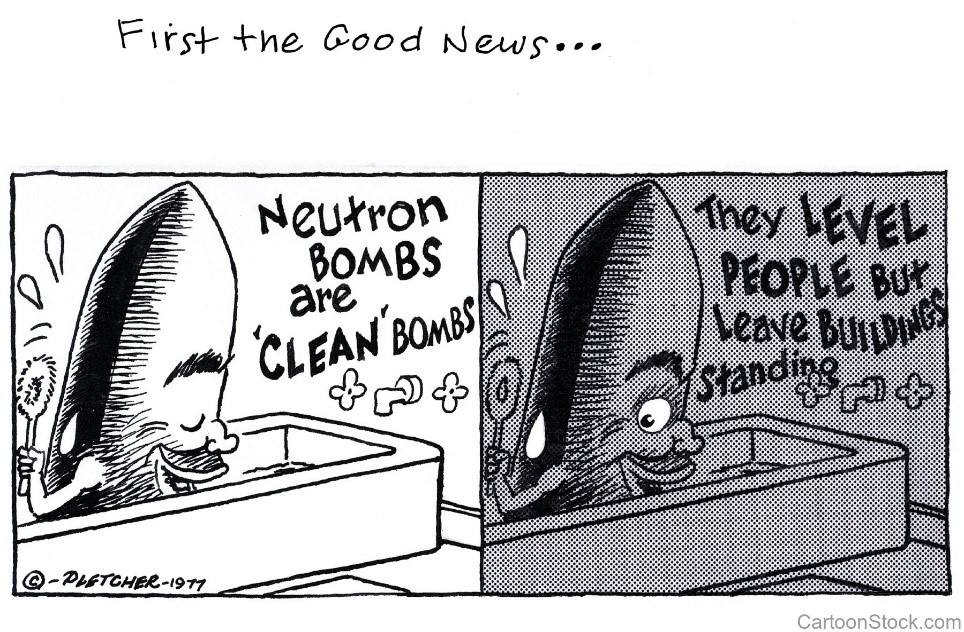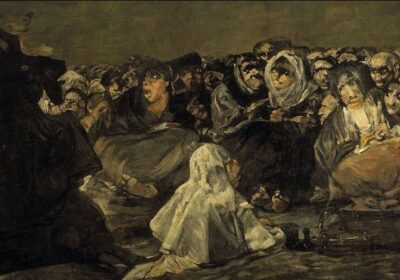NETANYAHU AND THE DREAM OF THE BIG BOMB

‘Dropping an atomic bomb on the Gaza Strip is one of the possibilities’. A statement made not by friends at the bar or drunkards, but by a minister in the current Israeli government. Is the taboo of using the atomic bomb against an enemy people therefore falling? The one who dropped the idea in a radio interview was Israeli Minister of Heritage Amihai Eliyahu, a member of the Jewish Power party led by the fanatic Itamar Ben Gvir, a convinced follower of Rabbi Meir David Kahane, famous for being in favour of the ideal of Greater Israel and the deportation of all Palestinians outside Israel.
This ultimate ethnic cleansing is supported by Ben Gvir himself[1] , the crutch that allowed Benjamin Netanyahu to go into government and who, not surprisingly, has collected at least 50 indictments for incitement to hatred.
For his part, Minister Eliyahu, like a good Kahanist, specified that as far as Gaza was concerned, ‘we would not provide humanitarian aid to the Nazis’ and that ‘there are no uninvolved civilians in Gaza’. And how to solve the now more than 70-year-old Palestinian problem? ‘They can go to Ireland or to the deserts’.
A few hours later PM Netanyahu suspended Eliyahu ‘from all government meetings until further notice’. Note well: NOT permanently, but only until further notice. This means that Eliyahu still remains minister.
Is the danger of resorting to atomic bombs thus averted? All well? Not quite. Not least because it is an old pet project of Netanyahu himself. But let us go in order.

1) – Towards the end of September 2006, at the sixth three-day international conference organised by the International Institute for Counter-Terrorism (ICT) at Marc Rich University in Herzliya[3] , a coastal city of 95,000 inhabitants, part of the metropolitan agglomeration of Tel Aviv, Netanyahu, then leader of the opposition, spoke. Presenting himself as a supporter of the ICT in front of an audience that officially included the fighters against terrorism, but in reality the most extremist supporters of the Israeli right, Netanyahu spoke first and in Hebrew. At the end of his speech, however, so that everyone could understand him without any possibility of misunderstanding, he spoke in English. And he spelled the last words well:
“The question is not whether to bomb Tehran with nuclear missiles. The question is when’.
We note en passant that this is a clear public admission of the possession of atomic bombs by Israel, which has always either alluded or denied it on this subject.
Three Italian journalists had also been invited to the conference: Paolo Fusi, Lorenzo Cremonesi and Guido Olimpio, the latter two both from Corriere della Sera. Cremonesi, however, probably smelled the air, decided not to attend, unlike Fusi and Olimpio. And there were those who, at those words – never condemned by either the US or the European states – got up and left: Paolo Fusi, a respectable CV. Disgusted, Fusi stayed locked in his hotel for the duration of the conference. i.e. for three days.
On 13 April two years ago – 2021 – in an article that also referred to what the current Israeli premier told Marc Rich University at the end of September 2006, Fusi accused Netanyahu and Turkey’s president Recep Tayyip Erdoğan of populist sovereignty and of aiming for a global conflict[4] . Regarding the Israeli premier, Fusi wrote:
“Netanyahu is wrong: there is no salvation for Israel in a military attack on Iran. There is no way to prevent Iran, sooner or later, from holding the atomic weapon – because its government does not give a damn about the welfare of its citizens and will go on its way regardless of sanctions. The only way forward is through diplomacy and peace as a real and effective option’.

2) – Everyone believes it is impossible to launch nukes on a tiny territory like the Gaza Strip because the radiation would also disastrously affect Israel itself. Right. But there is a but. Let’s see which one.
It is the A-bombs and H-bombs that release deadly and long-lasting radiation in large quantities, thus rendering the conquered territory and all its artefacts – industries, bridges, buildings, machinery, etc. – unusable by the victors for a long time. – These entrust their enormous destructive power to the gigantic explosion, the extremely high temperature and amount of heat released, and at least in the vicinity, the brutal displacement of air produced by the ‘bang’.
There are, however, atomic neutron bombs, known as N-bombs. They are designed so that the explosion is of low power and does not release significant amounts of persistent radiation, which is why they do not cause fallout. Neutron bombs have the virtue, if you want to call it that, of killing living beings, but without contaminating the territory with radiation for more than 24-48 hours. Which is then readily usable by the victor, including industries, armaments and artefacts.
In fact, it is the ideal weapon for targeting concrete buildings and underground tunnels. That is, the ideal weapon to use for the very long network of tunnels built in Gaza by Hamas at a depth of more or less 50 metres. This is why Israel could use it, should it possess any. Which is not unlikely because the inventor of the atomic N-bomb as well as the hydrogen H-bomb, which is enormously more powerful than the A-bomb also because it acts as a detonator, is the American Jew of Hungarian origin, Edward Teller, who has long been Israel’s own advisor on nuclear matters.

Teller is also the father of the so-called ‘star wars’, which consisted of launching missiles capable of intercepting incoming enemy missiles with atomic bombs. Teller’s idea had the advantage that it was not necessary to hit the incoming enemy missile or missiles, which was not easy, but that it was enough to launch a missile armed with an N-bomb to be detonated in their vicinity. The neutron storm would knock out the incoming N-bombs and prevent them from exploding.
I’ve always had a thing about atomic bombs. I studied physics at the University of Padua and then I also wanted to study nuclear engineering because I wanted to design atomic bombs so powerful that they would finally make wars impossible. Instead, life meant that instead of graduating and designing atomic bombs I took the path of journalism. When I was 14 or 15 years old, a high school student in Verona, I sent a letter to the Air Force command proposing that a neutron beam should be fired at the incoming atomic bombs to neutralise the fissile material.
In 1978, US President Jimmy Carter halted plans to produce N-bombs, but three years later, in 1981, President Donald Reagan allocated the necessary funds to start their production. Adopted by NATO as a tactical, battlefield nuclear weapon, i.e. with low explosive power but high killing capacity thanks to the neutron surge, it was later withdrawn from Europe when the Intermediate Nuclear Forces (INF) treaty was signed.
ITA037
[1] https://www.repubblica.it/esteri/2022/11/02/news/israele_netanyahu_ultradestra-372623694/
[2] https://www.timesofisrael.com/world-beating-a-path-to-israel-for-tech-pm-says/
[3] Back then it was organised by the IDC, the university created by Marc Rich
[4] https://theglobalpitch.eu/it/2021/04/13/netanyahu-as-erdogan-populists-struggle-for-a-global-conflict/
[5] https://juicyecumenism.com/2018/12/17/methodisms-neutron-bomb/
[6] https://chirirocktools.com/index.php?signed-edward-teller-3×5-index-father-of-the-hydrogen-bomb-120182.html ; https://www.nature.com/articles/468629a




Leave a Reply